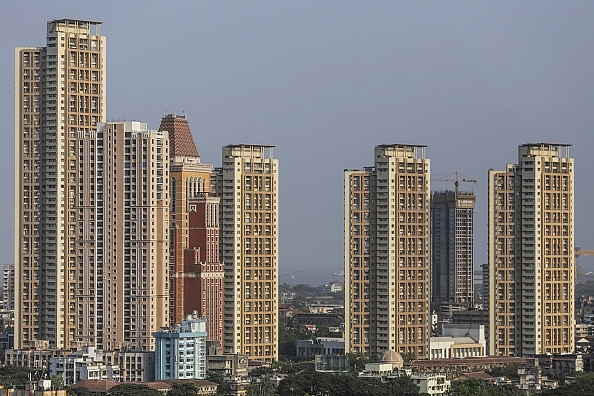Smart Cities
Smart Cities Need Smart Land Reforms And Regulations
- As part of Swarajya’s Smart Cities series, R Jagannathan explores why India’s smart cities need smart land reforms and smart regulations.
- Policies relating to land availability have been captured by vested interests – a cabal of corrupt politicians, bureaucrats, land sharks and builders, creating shortages.
- Smart Cities need a transparent land-use and building permits policy, and smart regulation too, so that land and construction costs can be cut to the bone.

Smart Cities - Mumbai (Dhiraj Singh/Bloomberg via Getty Images)
That India needs Smart Cities is a given. What is not a given is smart policy-making, especially policy-making in connection with land.
Cities are built on land. Cities grow based on the land they own, and the land they can acquire around the periphery or reclaim from the sea (if they are coastal cities, which is where smart cities of the future should be based). But this is exactly where policy-making goes dumb, as policies relating to land availability have been captured by vested interests – a cabal comprising corrupt politicians, bureaucrats, land sharks and builders.
But first let us debunk the myth that land is scarce. It is not. Land may be scarce in a particular area; if you want a flat in Delhi’s Defence Colony or Mumbai Malabar Hill or Bengaluru’s Koramangala, sure, land is pricey – and seemingly scarce.
But let us re-examine even this idea. Land is not just the square metres of plots currently available. Land is the square metres available multiplied by the floor-space-index (FSI). If you build higher (or even underground, as Singapore does), you get more square feet of property for the same piece of land. In short, land supply can be easily jacked up to meet demand if there is smart policy-making.
Then why are land prices rising, and property prices unaffordable?
Answer – bad policy, which is determined by the hidden beneficiaries (the vested interests mentioned above). Since the availability of land, building permissions, no-build zones etc are determined by politicians and bureaucrats in connivance with vested interests, the availability of land is artificially constrained by restricting permission, unless bribes are paid. These vested interests do this because they are the biggest benami investors in land, which is the biggest repository of black money right now.
The second myth worth busting is this: since population pressure is rising, even if more land is made available, land prices will have to rise based on increased demand.
Economist Ajay Shah of the National Institute of Public Finance and Policy wrote about it a few years ago explaining the dubious math that predicts rising land prices due to population pressures. He wrote: “If you place 1.2 billion people in four-person homes of 1,000 square feet each, and two workers of the family into office/factory space of 400 square feet, this requires roughly 1 percent of India’s land area assuming an FSI (floor space index) of 1. There is absolutely no shortage of land to house the great Indian population.”
If we have higher FSIs in urban centres (Smart Cities included), the actual land needed would be even lower – probably less than half a percent of India’s total available land supply. Assuming all the population congregates near a few cities, the figure could again rise to 1 percent, but remember, in cities more people get backed into smaller spaces.
The issue is also not of land alone. What is in real short supply is not land, but infrastructure. If you build a high-speed rail-cum-road network to a town 30 km away from an existing city, you will find that land prices will fall in the city, as people move to cheaper homes outside town as long as there is a suburban train or boat or fast bus taking them to workplaces within 45 minutes.
This is where the vested interests come in again. Land and property prices would crash in south Mumbai if a trans-harbour rail-cum-road link was built between Sewri (the landfall point on the island) and the mainland (South Mumbai is an island and there is a short stretch of sea separating it from the mainland where there is lots of land). With a trans-harbour link, people can get to south Mumbai in 30 minutes – a commute that can take more than 90 minutes now using existing roundabout rail and road links.
The takeout: Smart Cities need a transparent land-use and building permits policy. In general, packed cities need higher FSIs to reduce the land shortage, and redevelopment of old buildings, which can be given higher FSI and also asked to cede more road spaces from existing land owned. This is how the Sabarmati waterfront in Ahmedabad is being rebuilt. Smart land use policies actually create more land and more public and road spaces.
A few years ago, Credai (the Confederation of Real Estate Developers’ Associations of India) made a simple proposal to the Maharashtra government: cut down the approval time for building construction to 3-6 months, and we will cut property prices by 20 percent immediately.
This proposal reflects the time value of money, and shows how much delays caused by corruption and bureaucracy adds to property costs. Smart cities thus need smart regulation too, so that land and construction costs can be cut to the bone.
Introducing ElectionsHQ + 50 Ground Reports Project
The 2024 elections might seem easy to guess, but there are some important questions that shouldn't be missed.
Do freebies still sway voters? Do people prioritise infrastructure when voting? How will Punjab vote?
The answers to these questions provide great insights into where we, as a country, are headed in the years to come.
Swarajya is starting a project with an aim to do 50 solid ground stories and a smart commentary service on WhatsApp, a one-of-a-kind. We'd love your support during this election season.
Click below to contribute.
Latest